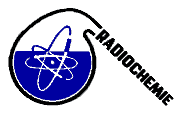Speaker
Mr
Ken Kersemans
(Vrije universiteit Brussel)
Description
It was recently reported that the success of O-(2’-[18F]fluoroethyl)-L-tyrosine ([18F]FET) as PET tracer is limited to brain, head and neck tumours and that there is still a need for more potent amino acid analogues for peripheral tumour imaging. We hereby report on the radiosynthesis of a new tracer 2-Amino-3-(4-[18F]fluoromethyl-phenyl)-propionic acid (4-[18F]FMP), taken up in tumours by the LAT1 amino acid transport system, performed with a customised Scintomics automatic synthesis hotboxthree module. The labelling reaction is based on Br for [18F] aliphatic nucleophilic exchange on 3-(4-bromomethyl-phenyl)-2-L-tert-butoxycarbonyl- amino-propionic acid tert-butyl ester. The critical point in the synthesis pathways was the deprotection of the NCA 3-(4-[18F]fluoromethyl-phenyl)-2-L-tert-butoxycarbonyl- amino-propionic acid tert-butyl ester obtained after labeling due to the highly activated 18F-benzyl group and the presence of a strong acid (trifluoroacetic acid). HPLC purification and mini-column trapping followed by appropriate recovery allowed to obtain NCA 4-[18F]FMP in a overall yield of 30% and with a radiochemical purity of > 99 %. This tracer was found to be stable in its radiopharmaceutical formulation for at least a working day, even at high radioactivity concentrations. Additionally, for a comparative clinical study, [18F]FET was synthesized applying the in literature described Tosyl [18F] aliphatic nucleophilic exchange followed by deprotection and HPLC separation using the same module set-up. Here a 40% overall yield is obtained with a radiochemical purity > 99%.
The described automated radiosynthesis module allows the high yield production of these two amino acid analogues with minor alternations to the parameter settings of the automated system, although two different labeling reactions are performed, rendering this unit versatile for both research and clinical practice.
Primary author
Mr
Ken Kersemans
(Vrije universiteit Brussel)
Co-authors
Prof.
John Mertens
(Vrije Universiteit Brussel)
Dr
Vicky Caveliers
(Laboratory of In Vivo Cellular and Molecular Imaging, Vrije Universiteit Brussel)

